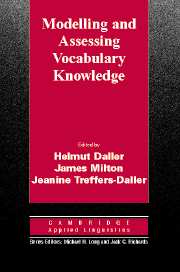Book contents
- Frontmatter
- Contents
- List of contributors
- List of abbreviations
- Acknowledgements
- Foreword
- Series Editors' Preface
- Editors' introduction
- I Fundamental issues
- II Vocabulary and learner differences
- Chapter 2 Lexical profiles, learning styles and the construct validity of lexical size tests
- Chapter 3 Learners' response behaviour in Yes/No Vocabulary Tests
- III The unit of assessment and multiple vocabulary measures
- IV Metaphors and measures in vocabulary knowledge
- V Vocabulary measures in use
- References
- Appendices
- Index
Chapter 3 - Learners' response behaviour in Yes/No Vocabulary Tests
Published online by Cambridge University Press: 04 May 2010
- Frontmatter
- Contents
- List of contributors
- List of abbreviations
- Acknowledgements
- Foreword
- Series Editors' Preface
- Editors' introduction
- I Fundamental issues
- II Vocabulary and learner differences
- Chapter 2 Lexical profiles, learning styles and the construct validity of lexical size tests
- Chapter 3 Learners' response behaviour in Yes/No Vocabulary Tests
- III The unit of assessment and multiple vocabulary measures
- IV Metaphors and measures in vocabulary knowledge
- V Vocabulary measures in use
- References
- Appendices
- Index
Summary
Introduction
In the introductory chapter of this book, Nation briefly addresses the contradiction that poor scores on vocabulary tests are not always a reflection of poor knowledge. In fact, bad test scores can be the result of several factors, including some that fall outside the scope of the construct being tested. He mentions some of these factors: participants may not have taken the test seriously, they may have proceeded too quickly in answering the test items, they may have lacked testtaking strategies or misused them. Such problems are common to all tests and language tests are no exception. This chapter will look in more detail at one particular problem associated with the checklist style of testing which is very popular in vocabulary testing. While the format is a popular one, it is unusual in language testing in that it tries through the use of false words to make some of the strategies used by testees explicit and to quantify and compensate for them. It is assumed that learners have control over the strategies they use and can show a true version of their vocabulary knowledge if they choose to present it. It is also assumed that the compensation mechanisms used in these tests can appropriately compensate for strategies such as guessing, and this process may sometimes lead to the conclusion that the results which learners present do not represent their real knowledge, as in the Yes/No Vocabulary Size Test (Meara and Buxton, 1987).
- Type
- Chapter
- Information
- Modelling and Assessing Vocabulary Knowledge , pp. 59 - 76Publisher: Cambridge University PressPrint publication year: 2007
- 9
- Cited by



